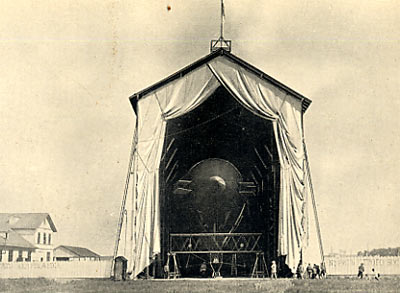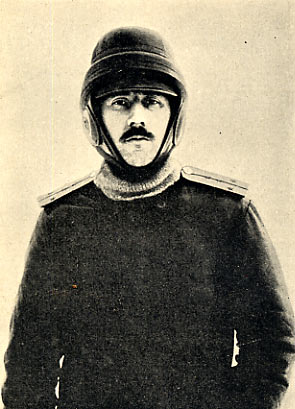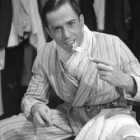Nick,was one of the stars of "Broadway Melody of 1936" - a TCM classic. His co-stars were Robert Stack, Buddy Epsen and Eleanor Powell. Why did his career go down the tubes?

- A Scotman in Russia
- The First Steps
- Russian Military Flying Schools
- The Imperial All Russia Aero Club
- General Baron Kulbars & Aviation
- The Imperial Russian Technical Society
- The Prototype of the Zeppelin
- Contruction, Aviators & Workmen
- Famous Russian Flying Men
- I.I. Sikorsky
- Foriegn Aviators in Russia
- Heir Fokker's Russian Lady Pilot
- Just Before the War
- Aerial Russia & the British Press
- Aviation & the Russian Press
- By Way of Conclusion

Chapter III - Russian Military Flying Schools

Mr. Kennedy opening the airship shed on the Korpusnoi Military Aerodrome at Petrograd, 1912.
Instructions were given that the Officers Central Aviation School, to which I have referred, should conduct a comprehensive survey of the whole question, and the result of this survey was that the War Office officially declared its adoption of the aeroplane. Flying schools were at once instituted in various parts of the Empire. The first school, to which reference has already been made, was opened in 1910 in Gatchino, a suburb of Petrograd, and the favourite residence of the Czar Alexander III. The chief was Lieut.-Colonel Ulianin, a well-known figure in Russian aviation circles, who has been in Paris during a great part of the present war. Lieut.-Colonel Ulianin began his career under the Command of Colonel - now General - Kovanko, and in pre-aeroplane days he made many flights in military balloons. He persuaded the War Office to allow him to invite the co-operation of civilian aviators and manufacturers, and both Mr. Stchetinin and Mr. Gakkel tested their machines in this military aerodrome. The world-famous Sikorsky pilot, Lieutenant Alechnovitch, began his career under the auspices of Lieut.-Colonel Ulianin, as indeed did most of the aviators who have distinguished themselves during the last two years. In 1911 Colonel Semkovsky initiated another aerodrome near Petrograd. It is one of the largest and most important in Europe, being five miles long and two miles wide. The dirigible "Koptchik," built from the designs of Colonel Nemtchenko, was launched from here in 1912, but since then it has been exclusively used for aeroplanes. Its chief was my old friend Colonel Hermann, a well-known Russian balloonist, who on one occasion suffered severe injuries during a descent, which injuries, by the way, in no way diminished his enthusiasm for flying. This aerodrome, called the Korpusnoi Aerodrome, may be regarded as the cradle of the Sikorsky giant planes. Here the first giants made their serious trial flights. It is a remarkable fact that, although the aerodrome has been the scene of ceaseless activity and experiment, not one single fatal accident has occurred there. On one occasion Sikorsky himself had a very bad fall in one of his smaller planes. Everyone expected that his dead body would be taken from the wreckage, but, as a matter of fact, he escaped without the smallest injury except the loss of four teeth.
When the aero--dynamic laboratory was opened in the Petrograd Polytechnk the War Office arranged that the officcrs attached to the flying corps should go through a course of study in the technics of the science of flight, and this step unquestionably led to a largely increased efficiency. Among the many students at the Polytechnic was Lieutenant Nesteroff, who looped the loop three days before Pegoud accomplished the same feat in France. The French aviator was furnished with a Bleriot machine specially built for looping. Nesteroff was flying in an ordinary military Nieuport, and this fact makes his achievement the more remarkable. Nesteroff was put under arrest for ten days for having taken undue risk with a machine which was the property of the Government. It is sad to note that both Pegoud and Nesteroff have lost their lives during the war while performing brilliant feats for the common cause.
The officers of the Southern Russian army were afforded opportunities for a thorough training in flying in the school established in Sebastopol by the Grand Duke Alexander Michailovitch. The first chid was Colonel Odinzoff, a staff college officer and one of the heroes of Port Arthur. He was succeeded by Captain Andriadi, an aviator whose career was as brilliant as it was tragically short. When he entered the Sebastopol School he was an infantry officer without distinction or influence. After two months' training he flew in a Nieuport monoplane from Sebastopol to Petrograd, but, unluckily, soon after he was appointed chief of the Sebastopol School, he was killed while testing a new machine.
Other schools were opencd by the War Office in the Caucasus, in Turkestan, in Siberia, and in other parts of the Empire, and it soon became possible for every section of the Russian army to educate its own officers and men in its own local aviation academy. The naval authorities followed the same plan as the War Office. Naval officers were allowed to attend the Sebastopol School v;rith their army comrades, and one of them, Lieutenant - now Lieut.-Commander - V. V. Dibobsky, was Captain Andriadi's competitor in the flight from Sebastopol to Petrograd. The effectiveness of the Sebastopol School has been amply proved by the success of Russian naval aviators in the Black Sea. Naval aviation in the Baltic had its first centre at Kronstadt, where a school was opened in 1910. It is interesting to remember that the flight of Lieutenant Piotrovsky from Kronstadt to Petrograd on a Bleriot monoplane established a record in those early days although to-day it would be a commonplace. It was soon discovered that the Kronstadt station was absolutely useless for hydroplanes. I t was first proposed to remove the headquarters to Hungerburg, close to Narva, where the mouth of the River Narova would have provided a capital hydroaeroplane harbour, but for some inexplicable reason the choice of the Naval Commission fell on Libau, where special docks were built in 1912. Mr. Sikorsky made many experiments here with his giant hydroaeroplanes and obtained good results, but it was a grievous mistake to set up an important station at Libau which the Russians were obliged to destroy so as not to allow it to fall into the hands of the enemy. When it became eyident that Libau must be abandoned, the seaplane dock was blown up and all the apparatus and material destroyed. Specialists agree that there was being brought into existence at Libau one of the most perfect aviation organisations in the world.

Left: Capt. N. A Jatsuk
The Russian Government indeed has not hesitated to spend enormous sums of money both on the construction of machines and on the education of the officers of the flying corps. This education is far more complete and comprehensive than in this country. Mr. Kennedy tells me, and this is an absolute fact, that even after a Russian pilot has obtained his certificate and passed through the schools he is expected to continue his study of aerial art. The education of the Russian pilot begins with an elementary acquaintance with the parts of an aeroplane. This enables him to become recognised at the local Aero Club, where he then learns to fly and, after an examination, receives his pilot's diploma. He then enters a military flying school, where he stays about six months, flying practically every day and in almost all weathers. After this period of training he must pass another examination for his military pilot's diploma. The tests are as follows:
(I) A flight at not less than 2000 metres.
(2) Volplane with cut-off engine from a height of not less than 1500 metres.
(3) A cross-country flight without stop of not less than 200 kilometres.
When he has obtained his military pilot's certificate, the officer must spend about seven months in one of the aero-dynamic laboratories, studying the theory of aviation, and he then must pass a difficult and searching examination. He is expected to know the construction of aeroplanes of all the principal types. He must be able to put together any type of aeroplane, selected by the examiner, without any prompting. He must prove his knowledge of motor mechanics and particularly of all the engines used by the Russian military and naval aviation corps. He must have a comprehensive knowledge of the history of aviation as well as of astronomy, meteorology, aerophotography, wireless telegraphy, and aerial and army strategy. If he can satisfy the examining commission in all these subjects and prove that he is a "finished flyer" on at least four different types of aeroplanes, he is admitted into the ranks of army pilots. In peace times, it generally happens that even after this the enthusiast will arrange to spend some time at the Central School at Petrograd, completing his knowledge of balloons, kites, and dirigibles. Without all this information, it is impossible to obtain distinction in the Russian Flying Corps. On one occasion Mr. Kennedy told me the namcs of nearly fifty Russian officers, most of whom I know, who are masters of naval as well as of military aviation.
The earnestness with which the Russian officer regards his profession is well illustrated by the career of Captain N. A. Jatsuk. After leaving school, Captain Jatsuk entered the naval engineering school, where he spent five years, and was then gazetted as a mechanical engineer in the navy. After three years' service he entered the Supreme Naval College. Successfully completing the course there, he was appointed first engineer on a destroyer on the Mediterranean and Black Sea Station, where he made many experiments with submarines, During the Russo-Japanese War, Jatsuk was with the fleet of Admiral Rojdestvensky. He took part in the Battle of Tsushima, was rescued from the water by the Japanese, and became a prisoner of war. By good luck he succeeded in escaping and reached Shanghai, from which port he made his way to Petrograd, where he at once began a course of studies at the Imperial Technological Institute. Soon afterwards aviation began to interest Captain Jatsuk. He learned to fly, and received a pilot's diploma from the Imperial All Russia Aero Club. He then qualified himself both as a military pilot and a naval pilot. He went through the course at the Central School, to which I have referred, and was given the title of "Aeronaut." He passed a special examination as a captain of dirigibles. He then obtained special distinction in the technics of aviation, which gave him the right to be called an "engineer of aviation," a very high Russian distinction. Before the war, he was for more than a year Director of the Imperial All Russia Aero Club School. Since the war began, Captain Jatsuk has performed steady and most valuable service as the commander of a small section of flying machines. "Believe me," said Mr. Kennedy, " Captain Jatsuk is 'no exception to his comrades. The Russian Flying Corps is full of such earnest and enthusiastic workers."
Captain Jatsuk, like the great Russian Admiral Makaroff, comes from the very heart of the Russian people, from one of those simple Russian villages which have given the nation so many thinkers, writers, artists, and soldiers, and whose spiritual resources are absolutely inexhaustible. When war broke out Russia had at its disposal about 300 highly trained military pilots, about 100 naval pilots, and more than 200 civilian pilots, while a large number of officers were in course of training at the various schools. Even the Germans were surprised at the extent of Russia's aerial resources, and Great Britain had no idea whatever of the progress made by her new ally.



